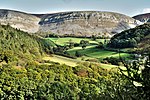St Mary's Church, Derwen
13th-century church buildings in WalesChurches preserved by the Friends of Friendless ChurchesEnglish Gothic architecture in DenbighshireFormer churches in WalesGrade II* listed buildings in Denbighshire ... and 5 more
Grade II* listed churches in DenbighshireGrade II listed buildings in DenbighshireGrade II listed churches in DenbighshireGrade I listed churches in DenbighshireScheduled monuments in Wales

St Mary's Church, Derwen, is a redundant church in the centre of the village of Derwen, Denbighshire, Wales. It is designated by Cadw as a Grade I listed building, and is under the care of the Friends of Friendless Churches.
Excerpt from the Wikipedia article St Mary's Church, Derwen (License: CC BY-SA 3.0, Authors, Images).St Mary's Church, Derwen
Geographical coordinates (GPS) Address Nearby Places Show on map
Geographical coordinates (GPS)
| Latitude | Longitude |
|---|---|
| N 53.0455 ° | E -3.3882 ° |
Address
LL21 9SF , Derwen
Wales, United Kingdom
Open on Google Maps







